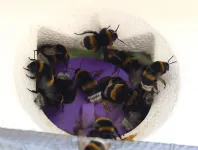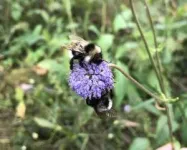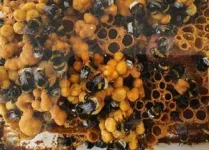(Press-News.org) Since the pandemic, we are very aware of the power of social distancing to protect against infectious disease. But can social distancing be effective if the infectious agent isn’t a virus or bacterium, but an insect powered by a brain and wings, and with the instinct to seek out new hosts?
Now, a study published to Frontiers in Bee Science has shown that physical distance does play a leading role in protecting bumblebees against a flying insect parasite, the bumblebee wax moth Aphomia sociella. The source of the potentially lethal infection was another species, namely nearby hives of domestic honeybees.
“Here we show that infestation with bumblebee wax moths is much greater in bumblebee colonies that are closer to honeybee apiaries,” said Dr Indrikis Krams, a professor at Daugavpils University and the University of Riga in Latvia, and the corresponding author of the new study.
“Because the presence of the moths lowers the bumblebees’ immune response and output of new workers and queens, the health and productivity of bumblebee colonies is lower near apiaries. This puts further stress on populations of these important pollinators, which are already declining around the world due to habitat loss, pesticides, and global warming.”
Like moths to a hive
Bumblebee wax moths, native in Eurasia and North Africa, seek out nests of bumblebees, honeybees, or wasps to lay their eggs. Young larvae feast on wax cells, pollen and nectar stores, and the corpses and droppings of the hosts, while older larvae attack living host larvae for food. Heavy infestations may wipe out their hosts or drive them abandon the nest. Infestations are easy to spot, as the moth larvae spin dense silk layers to protect themselves.
Krams and colleagues set out to study the impact of nearby honeybee colonies on buff-tailed bumblebees, Bombus terrestris. In 2019 and 2024, they placed a total of 25 boxed bumblebee colonies at a distance between zero and 600 meters from one of six small apiaries near Krāslava, Latvia. They regularly checked each bumblebee colony for the presence of wax moths, and counted open and closed brood cells as well as recently eclosed bees.
The experiment ran from spring until early July, when young bumblebee queens and males disperse to mate.
To gauge the immune response of individual bumblebees, the researchers used a well-established test, the encapsulation response assay. This involved piercing the abdominal exoskeleton of 260 bumblebee workers and introducing a 3mm-long sterile nylon filament through the puncture, which was left inside for five hours and then removed. Arthropods respond to the presence of parasites in their ‘blood’ by recruiting immune cells called hemocytes, which produce the pigment melanin to immobilize and kill the foreign bodies. The shade of the melanin capsule around the retrieved filament was taken as a proxy for the strength of immunity, which tends to increase with the health of the colony.
The results showed that bumblebee colonies closer to an apiary were more likely to become infested with wax moths: whenever this distance increased by one further meter, the probability of infestation decreased by 0.6%. Colonies closer to apiaries were also more productive: for every additional meter apart, the number of bumblebee queen and worker cells increased by 0.14 and 0.44 in healthy colonies, respectively, and by 0.08 and 0.348 cells in infested colonies. Finally, the encapsulation response was 3.5% stronger for every extra meter from the apiary.
Keeping wax moths at a respectful distance
The researchers concluded that bumblebee colonies do worse in terms of immunity and productivity as they are closer to honeybee colonies. This is likely due to a two-punch effect: shorter distances make it more likely that wax moths will disperse to find and attack bumblebee colonies, while the competition over flowers intensifies between the two bee species.
“The compromised immune system of bumblebees in colonies infested with wax moths may in turn make them more susceptible to other parasites or pathogens. This is a concern, because their populations are already declining,” said Krams.
“Conservationists and beekeepers should avoid placing apiaries in areas where pollinator biodiversity is high, as well as in areas where bumblebee populations are in decline. Plans for introducing honeybee apiaries should be devised to maximize pollination while minimizing the negative effects on bumblebee populations.”
END
How to protect bumblebee colonies safe from killer moths? Keep honeybee hives away from them
Bumblebee colonies closer to honeybee hives are more likely to attract voracious wax moths
2025-04-10
ELSE PRESS RELEASES FROM THIS DATE:
Rolling particles make suspensions more fluid
2025-04-10
Lacquers, paint, concrete—and even ketchup or orange juice: Suspensions are widespread in industry and everyday life. By a suspension, materials scientists mean a liquid in which tiny, insoluble solid particles are evenly distributed. If the concentration of particles in such a mixture is very high, phenomena can be observed that contradict our everyday understanding of a liquid. For example, these so-called non-Newtonian fluids suddenly become more viscous when a strong force acts upon them. For a brief moment, the liquid behaves like a solid.
This sudden thickening is caused by the particles present ...
Research fine tunes tools used to search for genetic causes of asthma
2025-04-10
Genome wide association studies (GWAS) have identified hundreds of genome regions containing thousands of genetic variants associated with asthma, but it’s still not clear which variants have an actual causal link to the disease. This “variant-to-function” gap is one of the biggest challenges to the usefulness of these genomic studies and has motivated researchers to develop new tools to make sense of GWAS results.
A new study by researchers from the University of Chicago combines genetic data and improved computational tools to look more closely ...
Meditation and critical thinking are the ‘key to meaningful AI use’
2025-04-10
People should learn to meditate and hone their critical thinking skills as AI becomes more integrated into daily lives, an expert suggests.
Digital strategy expert Giulio Toscani has spoken with 150 AI experts across 50 countries to understand the challenges and opportunities around human interactions with artificial intelligence.
He argues in his new book, Augmented: prAIority to Enhance Human Judgment through Data and AI, that as humans operate largely unconsciously by design, they are inclined toward immediacy and instant rewards, often overlooking potential ...
Studies shows new class of antibiotic is effective in tackling MRSA
2025-04-10
The development of new antibiotics to treat superbugs and other bacterial infections is a global priority, with the rate of infections that cannot be treated with current antibiotics rising and presenting one of the biggest threats to human health.
In line with that, new research has shown a daily dose of epidermicin NI01 – an antibiotic compound developed by University of Plymouth spinout company Amprologix – is as effective at removing Methicillin-resistant Staphylococcus aureus (MRSA) as the current standard of care.
The results were achieved through a robust skin MRSA infection model, and those behind the research say it justifies ...
Certain nasal bacteria may boost the risk for COVID-19 infection, study finds
2025-04-10
WASHINGTON (April 9, 2025) — A new study from researchers at the George Washington University has found that certain bacteria living in the nose may influence how likely someone is to get a COVID-19 infection. Published in EBioMedicine, the research reveals that certain types of nasal bacteria can affect the levels of key proteins the virus needs to enter human cells, offering new insight into why some people are more vulnerable to COVID-19 than others.
“We’ve known that the virus SARS-CoV-2 enters the body through the respiratory tract, with the nose being a key entry point. What’s new—and surprising—is that bacteria in our noses ...
Europe's population is adapting better to cold than to heat
2025-04-09
A study led by the Barcelona Institute for Global Health (ISGlobal), a centre supported by the "la Caixa" Foundation, has shown that Europe has adapted better to low temperatures than to high temperatures over the last two decades. The research, carried out in collaboration with the Barcelona Supercomputing Centre (BSC) and published in The Lancet Planetary Health, shows that there has been a significant decrease in cold-related mortality risk in recent years compared to the first decade of the 2000s. There has also been a reduction in the risk of heat-related ...
Ancient tools from a South African cave reveal connections between prehistoric people
2025-04-09
In a cave overlooking the ocean on the southern coast of South Africa, archaeologists discovered thousands of stone tools, created by ancient humans roughly 20,000 years ago. By examining tiny details in the chipped edges of the blades and stones, archaeologists are able to tell how the tools were made. In a new study published in the Journal of Paleolithic Archaeology, researchers analyzed these stone tools and discussed how the different techniques used to make them hint at the ways that prehistoric people traveled, interacted, and shared their craft.
“This is an important insight into how people who lived in this region ...
World’s first birth following conception with a fully automated remotely operated ICSI system
2025-04-09
10 April 2025: The world’s first baby has been born following conception with a fully automated, digitally controlled intracytoplasmic sperm injection (ICSI) system. ICSI, developed and adopted into widespread use in the 1990s and now a routine method of assisted conception, achieves fertilisation by injecting a single sperm cell into the centre of a mature egg.
The details are reported today in the peer-review medical journal Reproductive Biomedicine Online.(1) The automated system was described and developed by a multidisciplinary team of specialists from Conceivable ...
Girls’ education projects succeed when whole communities ‘live the change’ and carry it forward
2025-04-09
Education projects supporting marginalised girls in lower-income countries are more likely to achieve lasting transformations when they mobilise young women and their communities as “agents of change”, a new report indicates.
The recommendation comes from the latest evaluation of the Girls’ Education Challenge: a UK Government-supported initiative which has funded projects reaching more than 1.6 million girls. The University of Cambridge-led study finds that these projects initiated “virtuous cycles” of change – particularly by rooting themselves in communities and empowering young women to lead the way.
In ...
European bird declines linked to range of climatic conditions experienced
2025-04-09
New research suggests conservation efforts could more effectively identify and protect bird species at greatest risk from climate change by better understanding the range of specific conditions they need to thrive.
The study, led by the University of East Anglia (UEA), examined the relationship between the extent of the climatic conditions that species tolerate and in which populations can survive - known as climatic niche breadth - and their likelihood of declining in response to climate change.
For species inhabiting a similar area of geographic space, those able to tolerate ...
LAST 30 PRESS RELEASES:
Scientists discover ‘platypus galaxies’ in the early universe
Seeing thyroid cancer in a new light: when AI meets label-free imaging in the operating room
Neutrophil-to-lymphocyte ratio may aid risk stratification in depressive disorder
2026 Seismological Society of America Annual Meeting
AI-powered ECG analysis offers promising path for early detection of chronic obstructive pulmonary disease, says Mount Sinai researchers
GIMM uncovers flaws in lab-grown heart cells and paves the way for improved treatments
Cracking the evolutionary code of sleep
Medications could help the aging brain cope with surgery, memory impairment
Back pain linked to worse sleep years later in men over 65, according to study
CDC urges ‘shared decision-making’ on some childhood vaccines; many unclear about what that means
New research finds that an ‘equal treatment’ approach to economic opportunity advertising can backfire
Researchers create shape-shifting, self-navigating microparticles
Science army mobilizes to map US soil microbiome
Researchers develop new tools to turn grain crops into biosensors
Do supervised consumption sites bring increased crime? Study suggests that’s a myth
New mass spec innovation could transform research
Maternal nativity, race, and ethnicity and infant mortality in the US
Migration-related trauma among asylum seekers exposed to the migrant protection protocols
Jupiter’s moon Europa has a seafloor that may be quiet and lifeless
SwRI upgrades nuclear magnetic resonance laboratory for pharmaceutical R&D
House sparrows in northern Norway can help us save other endangered animals
Crohn's & Colitis Foundation survey reveals more than 1/3 of young adults with IBD face step therapy insurance barriers
Tethered UAV autonomous knotting on environmental structures for transport
Decentralized social media platforms unlock authentic consumer feedback
American Pediatric Society announces Vanderbilt University School of Medicine as host institution for APS Howland Visiting Professor Program
Scientists discover first method to safely back up quantum information
A role for orange pigments in birds and human redheads
Pathways to net-zero greenhouse gas emissions for Southeast Asia
A JBNU–KIMS collaborative study on a cost-effective alloy matches superalloys for power plants and energy infrastructure
New study overturns long-held model of how plants coordinate immune responses.
[Press-News.org] How to protect bumblebee colonies safe from killer moths? Keep honeybee hives away from themBumblebee colonies closer to honeybee hives are more likely to attract voracious wax moths







